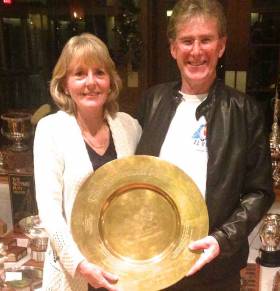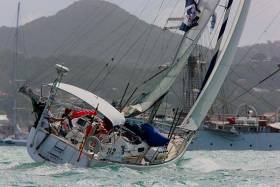Displaying items by tag: Irish Cruising Club
The sixty-boat twelve-day Irish Cruising Club Cruise-in-Company in northwest Spain comes to a conclusion in Bayona tonight after an impressive display of well-planned logistics by lead organiser Peter Haden and his team writes W M Nixon. This saw the many participants provided with a reasonable number of options in organised events afloat and ashore, yet at the same time there was plenty of scope for “cruises-within-the-cruise” for smaller groups of buddy-boats in the fleet.
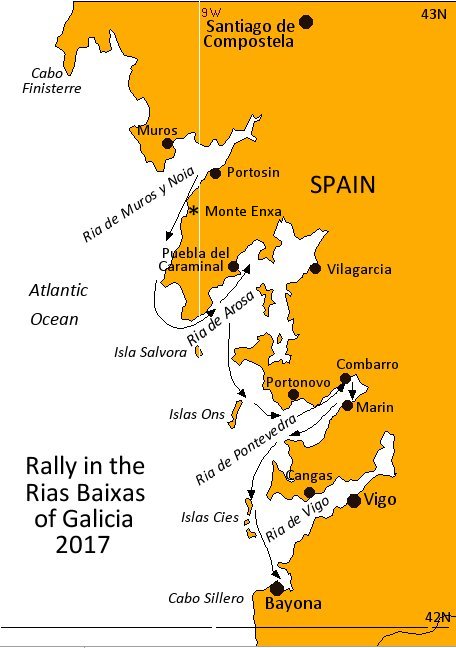 This chartlet indicates the broad movement southward of the 60-boat fleet – there were many options available for private ventures by smaller numbers of boats. In addition, with a significant Ocean Cruising Club contingent within the ICC membership, a joint meet with raft-up possibilities was organised with the OCC on Tuesday of this week at Ensenada de Barra. This produced a notable array of renowned cruising vessels, many of which have voyaged tens of thousands of miles.
This chartlet indicates the broad movement southward of the 60-boat fleet – there were many options available for private ventures by smaller numbers of boats. In addition, with a significant Ocean Cruising Club contingent within the ICC membership, a joint meet with raft-up possibilities was organised with the OCC on Tuesday of this week at Ensenada de Barra. This produced a notable array of renowned cruising vessels, many of which have voyaged tens of thousands of miles.
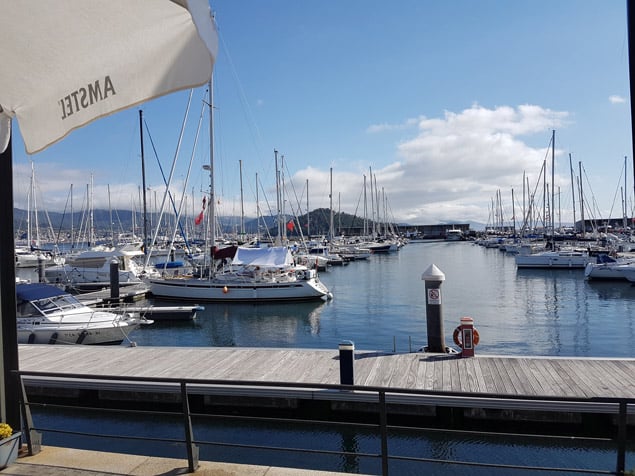 The ICC fleet used both marinas and anchorages – this was one of the early overnights at Caraminal. Photo: Tansey Millerick
The ICC fleet used both marinas and anchorages – this was one of the early overnights at Caraminal. Photo: Tansey Millerick
While the early days of the rally saw some fog and even a spot of rain, as the fleet has progressed southward from Portosin towards Bayona the conditions have steadily improved, and they are now well clear of the unsettled weather which has been developing beyond the northern areas of the Bay of Biscay.
In fact, it is currently Galicia at its very best, and the organisers who calmly kept at the job despite numbers involved soaring through all expectations, and the many boats which voyaged both from Ireland and other places to share the ethos of this remarkable club in a very special setting, deserve much credit for a combined effort which well expresses the spirit of the Irish Cruising Club.
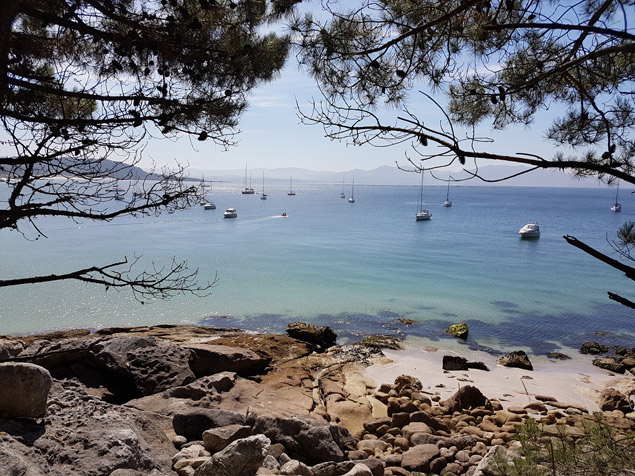 Galicia at its best – a daytime beach anchorage off Ensenada de Barra. Photo: Tansey Millerick
Galicia at its best – a daytime beach anchorage off Ensenada de Barra. Photo: Tansey Millerick
The Irish Cruising Club’s 2017 Rally in northwest Spain begins its stately progress southwards today from the fleet assembly point of Portosin writes W M Nixon With its organisation ably led by experienced Galician cruiser Peter Haden (whose home port is Ballyvaughan on Galway Bay), the event has far exceeded expected fleet numbers in reaching the 60 mark for a very diverse assembly of cruising yachts.
This has meant that although the notably talented ICC team running the event have put together a formidable information package and programme for those taking part, the sheer numbers mean that they’ve had to very definitely restrict participation in the carefully rationed special shore event and anchorage assemblies only to those who have officially signed up.
 One of Europe’s most attractive cruising areas is being put to good use for the ICC’s 60-boat Galician Rally, which starts heading southward this morning on a ten day programme
One of Europe’s most attractive cruising areas is being put to good use for the ICC’s 60-boat Galician Rally, which starts heading southward this morning on a ten day programme
A successful cruise-in-company is a decidedly finely-judged affair, as you have to organize sufficient specific events to give the fleet movement a sense of coherence, yet at the same time you have to allow for the fact that genuine cruising enthusiasts will want time to themselves, while others will want to form small mini-groups having their own cruises-within-the-cruise.
With the rally making full use of one of Europe’s finest cruising areas, the experiences of the next ten days should provide a unique opportunity for those new to Galicia to get to know one of the most interesting corners of Europe. And as for the local people who live there in the many and varied coastal villages and small towns, quite what they’ll make of 60 Irish boats and their enthusiastic crews making their way along their fine coast remains to be seen. But we’ve no doubt that many new and enduring friendships will emerge.
 Far into the future, the 2017 Galician Rally flag will be a treasured souvenir
Far into the future, the 2017 Galician Rally flag will be a treasured souvenir
Daragh Nagle, an ex-Pat Dub who live and sails from Victoria on the west coast of Canada, is the Afloat.ie “Sailor of the Month” for February in honour of his award of the Irish Cruising Club’s premier trophy, the Faulkner Cup, for a notably varied voyage in the Pacific from Mexico to Hawaii and then eastward back to Canada.
Although this was island-hopping in what was only a part of the Pacific, for anyone accustomed to the smaller scale of the Atlantic, the distances seem enormous. By the time Daragh’s 29-year-old Moody 346 Chantey V returned to her home port, she’d logged a total of 7,858 miles during 2016 as part of a three year venture which has seen a total of more than 25,000 miles sailed.
It was a challenging programme. But with his skillfully-updated veteran 37-footer, and well-thought-through crew changes which saw his wife Cathy sailing many of the stages involved, Daragh made a real dream cruise which has been deservedly rewarded by his home club, more recently by the Irish Cruising Club, and now by the “Sailor of the Month” award for February 2017.
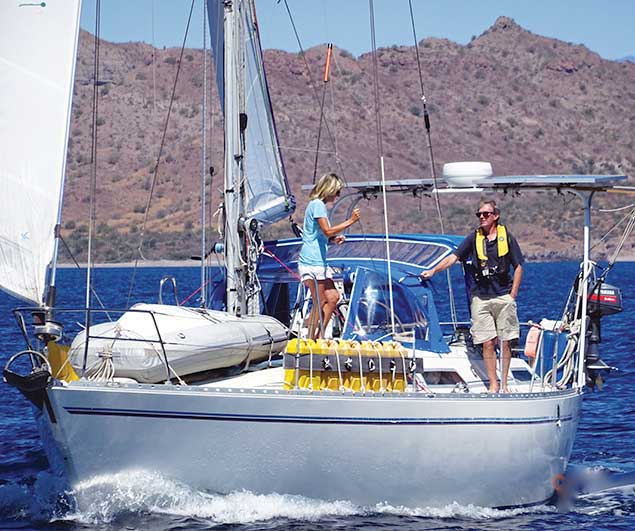 The 29-year-old Moody 376 Chantey V in the Sea of Cortez in Mexico shortly before departing for the long haul direct to Hawaii
The 29-year-old Moody 376 Chantey V in the Sea of Cortez in Mexico shortly before departing for the long haul direct to Hawaii
Irish Sailing's Silent Cruising Majority Are Vocal This Weekend
Cruising is the side of sailing which sometimes finds it difficult to make its voice heard. Its essence is in the quiet enjoyment of seafaring and the peace of secluded anchorages. Unlike the absolute clarity of racing results, which create their own noise and are energised by a sense of competition with others, cruising folk are in competition mainly with themselves, and with their own self-reliant ability to see a voyaging venture brought to a successful conclusion. W M Nixon takes us through a weekend which is cruising-oriented, and concludes tomorrow with a celebration at the home port of Irish cruising’s most legendary figure.
In previewing the prospects for the sailing season of 2017 a couple of months ago, we suggested that it would be The Year of the Everyday Sailor. For inevitably, 2016 was a year of the high profile happenings featuring superstars, events such as the Volvo Round Ireland Race from Wicklow, the KBC Laser Radial Youth Worlds in Dun Laoghaire, and the absolute peak in Rio de Janeiro, Annalise Murphy’s Olympic Silver Medal.
But 2017 sees a total change of emphasis. With a clear two or three years before the 2020 Olympics start to come up the public agenda again, it’s time to savour and enjoy the sort of sailing most of us do all the time. Local events, neighbourhood regattas, regional offshore and club racing, and that most indefinable of all waterborne activities - cruising.
Last night in Dublin, the Irish Cruising Club held its Annual General Meeting and Prize Giving in which the logs of outstanding cruises – activities which usually stay well under the radar – were given full recognition.
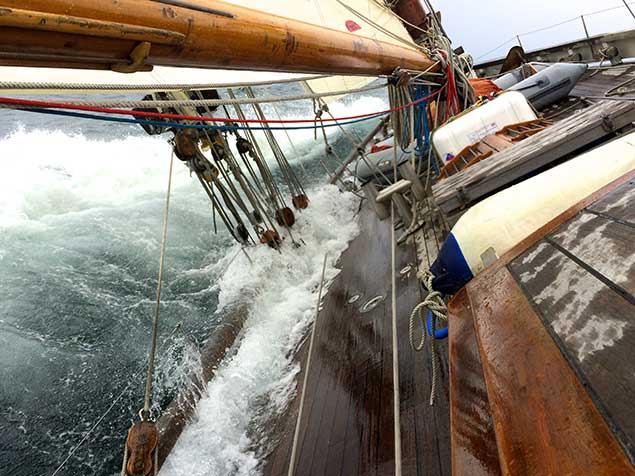 The rugged power of a seaworthy vessel – Annabelle J on passage from Smerwick Harbour in the Dingle Peninsula to Kilronan in the Aran Islands during her 2016 cruise on Ireland’s Atlantic seaboard Photo: Maire breathnach
The rugged power of a seaworthy vessel – Annabelle J on passage from Smerwick Harbour in the Dingle Peninsula to Kilronan in the Aran Islands during her 2016 cruise on Ireland’s Atlantic seaboard Photo: Maire breathnach
Today in Cork, the Irish Sailing Association/Cruising Association of Ireland Annual Cruising Conference is being staged, and it has attracted so much interest that the venue has had to be moved to larger premises than originally planned. As last night’s ICC AGM was a distinctly crowded affair too, clearly the interest in cruising is stronger than ever. But quite how many have managed to attend both events we won’t know until this morning, yet it’s just about possible with a bit of early morning discipline.
Then tomorrow, the focus swings northwestward from Cork to Foynes on the Shannon Estuary, where a Family Day from 2.30pm to 5.30 pm sees a celebration of Foynes Yacht Club becoming the new Volvo ISA Training Centre of the Year, with ISA President David Lovegrove doing the honours for a club which is the very essence of voluntary enthusiasm and community spirit.
Of course, many of the 200 or so young people who emerge from the Foynes Yacht Club Sailing Academy hope to go on to the highest level of racing success. But equally, they will find their talents in sailing much appreciated aboard keenly-sailed cruising boats. And the club has a solid record in offshore racing, with FYC’s Simon McGibney the current Commodore of the Irish Cruiser Racing Association, while father-and-son team Derek and Conor Dillon from Listowel have sailed their Dehler 34 under the Foynes colours to win the two-handed division in the Round Ireland Race.
And then beyond that, Foynes was home port to the great Conor O’Brien (1880-1952) of 1923-1925 Round the World fame. He lived out his final days on Foynes Island, and is buried in the nearby churchyard, but the recently-confirmed plans to build a replica of his famous 40ft ketch Saoirse in her 1922 birthplace of Baltimore will draw further favourable attention to everything that Foynes has done, and is doing, for Irish sailing – racing and cruising alike.
It’s all interconnected, for when the Irish Cruising Club was formed in Glengarriff on Bantry Bay on 13th July 1929, one of the first things they did was make Conor O’Brien an honorary member, and the first time I saw the noted portrait of Conor O’Brien sketched by his wife Kitty Clausen, it was in Foynes YC more than a few years ago..
 Always remembered. The model of Saoirse in Foynes Museum reminds us that she will soon be re-created full size
Always remembered. The model of Saoirse in Foynes Museum reminds us that she will soon be re-created full size
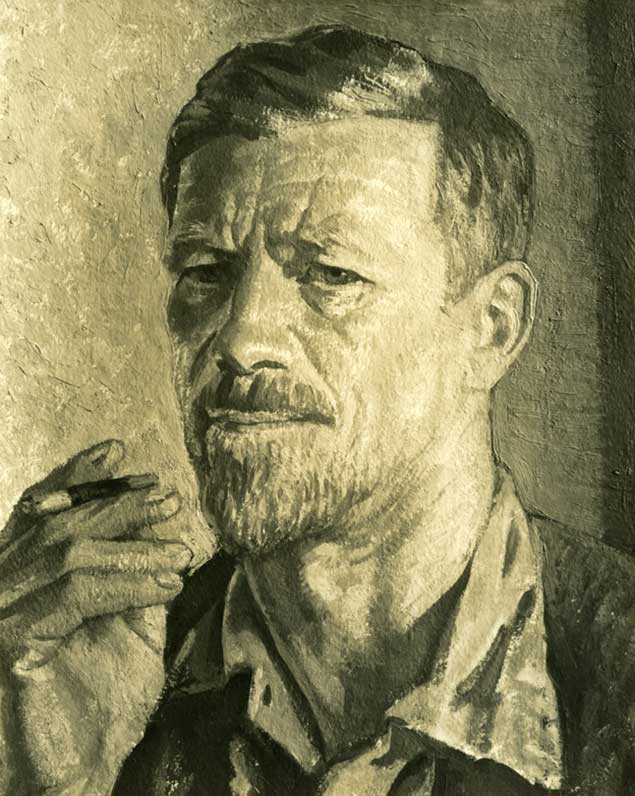 The portrait of Conor O’Brien by his wife Kitty Clausen, seen for the first time in Foynes Yacht Cub.
The portrait of Conor O’Brien by his wife Kitty Clausen, seen for the first time in Foynes Yacht Cub.
So last night’s ICC post-AGM dinner was well peopled with friendly ghosts, but as well it was a celebration of some really remarkable cruises on every scale. Then too, it marked two significant changes of the watch with Peter Killen of Malahide, who led by example with his Amel Super Maramu 54 ketch Pure Magic seemingly always on the move, retiring as Commodore to see the to post go north to Stanton Adair of Belfast Lough, a long-serving committee member and flag officer who will be leading his members in the ICC Cruise-in-Company to the Galician Rias of Northwest Spain this summer in his well-travelled Beneteau Oceanis 43 Grand Cru.
However, while Commodores and other top officers may be the public face of the ICC, the strength of the club is in its voluntarily-produced publications, with Honorary Editors who between them keep the two volumes of Sailing Directions for the entire Irish coast up to date with notable rigour, and produce an Annual journal of the club’s cruising logs.
Norman Kean of Courtmacsherry is very much in charge of the Sailing Directions which are publicly available, and he’ll be one of the keynote speakers at today’s conference in Cork. But in their way the logs in all their rich variety in the Annual can be every bit as informative, particularly as the club is now so far-ranging that its members can be found cruising on most of the planet’s oceans.
Here, there has been another change of the watch, with Ed Wheeler from he north producing his final and as ever excellent Annual to cover the 2016 season, and after four years he hands over to noted sailor/musician/writer Maire Breathnach of Dungarvan. Or at least she’s from Dungarvan and she spends about a third of her time there, but as she’s married to another formidable voyager, Andrew Wilkes of Lymington on the south coast of England, they spend about a third of their time there, where - with other Irish ex-Pats - they’ve created a sort of West Hampshire Gaeltacht.
 Maire Breathnach off Cape Horn at the helm of Andrew Wilkes’ Swan 44 King of Hearts during their cruise round South America in 2004. Photo: Andrew Wilkes
Maire Breathnach off Cape Horn at the helm of Andrew Wilkes’ Swan 44 King of Hearts during their cruise round South America in 2004. Photo: Andrew Wilkes
 The new girl in town. Annabelle J as seen recently from Reginalds Tower in Waterford, with the sail training ketch Brian Boru astern. Photo Maire Breathnach
The new girl in town. Annabelle J as seen recently from Reginalds Tower in Waterford, with the sail training ketch Brian Boru astern. Photo Maire Breathnach
However, the remaining third of their time is maybe most interesting of all, as its spent aboard their gorgeous 55ft gaff cutter Annabelle J, which they bought about 18 months ago to replace their steel gaff yawl Young Larry, with which they’d transitted the Northwest Passage.
The 1996 steel-built Annabelle J first entered Irish maritime consciousness during her previous ownership in 2013, when she was undoubtedly the Queen of the Fleet during the Old Gaffers Golden Jubilee Cruise-in-Company, which took in both Dublin and Belfast. However, if you’ve progressed along the waterfront in Waterford recently, you’ll see her there near Reginald’s Tower, berthed just ahead of the Sail Training ketch Brian Boru, for she’s simply too big to fit into the handy little pool just below the bridge in Dungarvan which Young Larry used to make her winter home.
Although she’s “only” 55ft long in overall hull length, Annabel J is 66ft from nose to tail with spars included, and she speaks “ship” rather than “yacht”. The basic design was by David Cox completed by Gary Mitchell and she was constructed by shipbuilders A & P of Appledore in Devon. Yet while they admit to Bristol Pilot Cutter influence on her design, the original owners made no direct claims for this, but the fact is that she’s such a strikingly handsome vessel that it’s difficult not to see her as the definitive modern version of a pilot cutter, even if she’s larger than most of the original Bristol Channel boats.
For Maire and Andrew, taking on such a vessel was a leap in the dark until they could be confident they could handle her with just the two on board, but a cruise of Ireland’s west coast to Donegal and back in 2016 – including a transit of the Joyce Sound pass inside Slyne Head – showed them they could manage her both in confined waters and at sea, so for 2017 the far horizons call.
However, for 2017 there’s also the additional challenge that Annabel J is now editorial headquarters for the most important annual record of Irish cruising achievement, but her crew being aces in the communications business, they’ll take it all in their stride even if Ed Wheeler has left a very high standard to maintain.
For his final edition of the Annual, the adjudicator for 2016’s logs was former Commodore Cormac McHenry, himself a Transatlantic veteran, and although the ICC now has an enormous selection of trophies to highlight various specialities of achievement, nevertheless he had to by-pass some very notable cruises in order to make his final selection.
The ICC’s premier trophy, dating back to 1931, is the Faulkner Cup, and its latest award is to Daragh Nagle, a member based in Victoria on Canada’s west coast, from where he cruises extensively with his wife Cathy and others in his 1987-built Moody 376 Chantey V.
 Cathy & Daragh Nagle aboard Chantey V in the Sea of Cortez on the west coast of Mexico.
Cathy & Daragh Nagle aboard Chantey V in the Sea of Cortez on the west coast of Mexico.
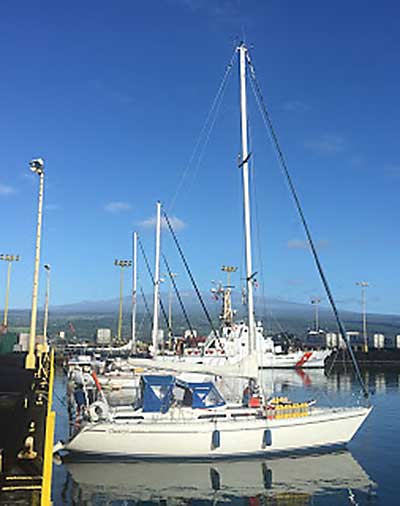 Chantey V is a standard Moody 376, designed by Bill Dixon and built 1986.
Chantey V is a standard Moody 376, designed by Bill Dixon and built 1986.
Chantey V’s 2016 cruise was from San Salvador on the Pacific Coast of Central America northwest along the Mexican coast to the long inlet of the Sea of Cortez, followed by the big ocean hop to the Hawaii Islands, before heading eastward back to Canada.
For the long haul out to the islands, he recruited Portuguese-based ICC member John Duggan as first mate, a role he filled with added diligence as he also obligingly wrote up the log of that stage of the voyage – other first mates please note. And as his skipper was unable to collect the Faulkner Cup last night in person as he is at a family wedding in Malaysia, John Duggan was in Dublin last night to do it for him.
His views on the Pacific between West Coast America and Hawaii were interesting. He says it may seem Pacific after you’ve battled your way round Cape Horn, but by comparison with his usual Atlantic stomping grounds, it seemed an oddly unsettled area of water, with twitchy little waves patterns running every which way.
 Man aloft. Daragh Nagle rigging an emergency inner forestay in mid-Pacific. Photo John Duggan
Man aloft. Daragh Nagle rigging an emergency inner forestay in mid-Pacific. Photo John Duggan
In fact, the going was so jerky at times that Chantey V broke her baby stay. The word from riggers is that the shorter the stay, the less able it is to absorb sudden snatches in loading. But whatever caused it, Darren Nagle spent a few hours getting well bruised at the lower spreaders before he’s rigged a satsfactory temporary baby stay to the stemhead to keep the rig in place for the rest of the voyage. By the time Chantey V got back to Victoria, this cruise totalled 7,858 miles for 2016, and just under 25,000 miles since they started their North America circuit three years ago.
As it happens, the Strangford Cup for an alterative best cruise goes to a venture which John Duggan has done a couple of times with his own 40-footer Hecuba, from the Iberian peninsula out to the Azores and then cruise in detail before returning to Spain or Portugal. In 2016 this very Atlantic cruise was undertaken by Seamus OConnor with his new Hallberg Rassy 42, and with three weeks in the Azores, he produced a mass of interesting information in addition to obviously enjoying himself, which is really what cruising is supposed to be all about.
Enjoyment takes many forms, yet cruising to northeast Greenland would not be many people’s first choice. But Brian Black of Strangford Lough finds he’s drawn back there seemingly year after year in his fairly standard 1985-built Trident Voyager Seafra. He writes of it in such an unassuming yet elegant way that his cruise first to the Faeroes then eastward of Iceland to Ittoqqortoormiit in northeast Greenland (it’s just south of the latitude of Jan Mayen) wins him the Wild Goose Cup for a log of real literary merit, and in it he finds the time to tell us of gig racing in the Faeroes and a visit to his favourite Arctic anchorage of Jyttes Havn.
 Gig racing in the Faroes as watched by Brian Black while cruising towards northeast Greenland. Photo: Brian Black
Gig racing in the Faroes as watched by Brian Black while cruising towards northeast Greenland. Photo: Brian Black
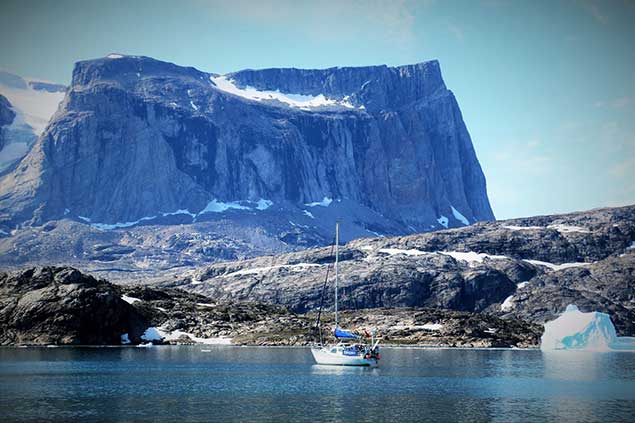 Favourite Arctic anchorage. Seafra in Jyttes Havn, Greenland. Photo: Brian Black
Favourite Arctic anchorage. Seafra in Jyttes Havn, Greenland. Photo: Brian Black
The sun may have shone for Seafra in Jyttes Havn, but far to the southwest in Labrador, Neil Hegarty and his shipmates on the Dufour 34 Shelduck found the weather classic Grand Banks cold and foggy as they readied their Dufour 34 Shelduck for a rugged but efficient passage to Baltimore in West Cork via Newfoundland to complete a three year Atlantic circuit which has been already been garlanded with awards, and now adds the Atlantic Trophy to its laurels.
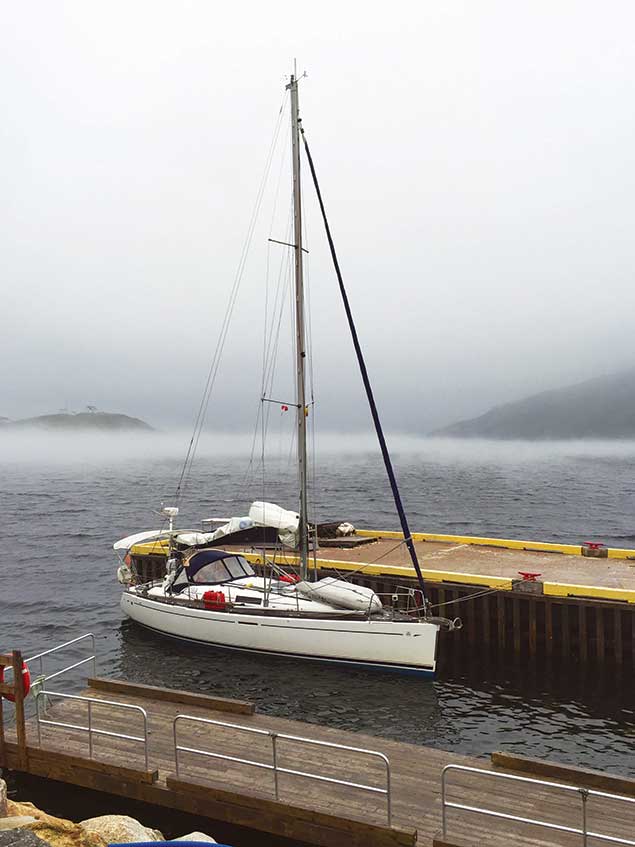 Cold and foggy. Neil Hegarty’s Shelduck at Red Bay, Labrador. Photo Neil Hegarty
Cold and foggy. Neil Hegarty’s Shelduck at Red Bay, Labrador. Photo Neil Hegarty
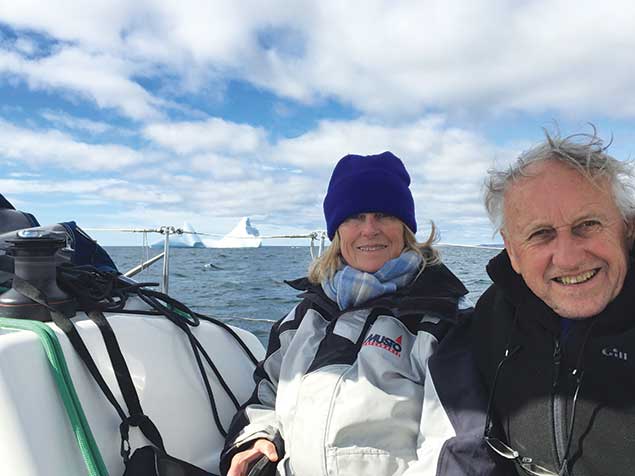 Homeward bound. Neil Hegarty (right) with Ann Kenny of Tralee and icebergs off St Anthony, Newfoundland
Homeward bound. Neil Hegarty (right) with Ann Kenny of Tralee and icebergs off St Anthony, Newfoundland
Even the briefest summary of the other main awards doesnl’t do them justice, but it gives some idea of the ICC’s level of activity:
Fortnight Cup: Best cruise within 16 days, Adrian & Maeve bell of Strangford Lough in the Baltic with their Arcona 430 Oisin Ban.
Round Ireland Cup: Donal Walsh of Dungarvan with his newly-acquired Ovni 385 Lady Belle. Thanks to his new boat’s lifting keel, not only was he able to explore shallow ports seldom visited such as Belmullet and Donegal town, but the fact that an Ovni is well able for seafaring meant he made St Kilda part of a round Ireland cruise while he was at it.
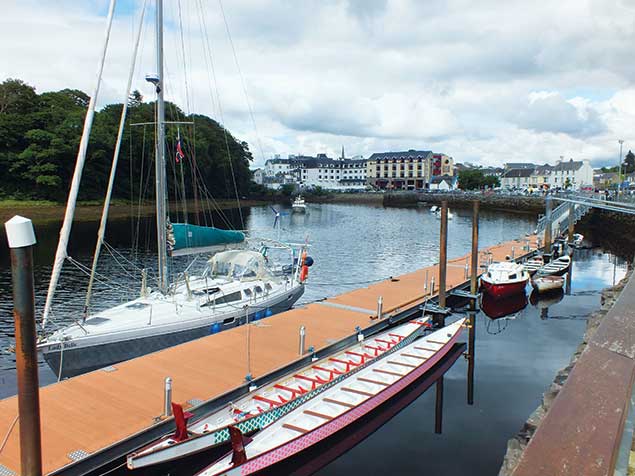 Donal Walsh’s newly-acquired Ovni 385 Lady Belle showing her versatility by comfortably finding enough water with keel raised to visit Donegal town (above), while she also made the passage out to St Kilda (below) with no bother. Photos Donal Walsh
Donal Walsh’s newly-acquired Ovni 385 Lady Belle showing her versatility by comfortably finding enough water with keel raised to visit Donegal town (above), while she also made the passage out to St Kilda (below) with no bother. Photos Donal Walsh

Fingal Cup: for the log which the judge most enjoyed goes most deservedly to Peter Fernie of Galway for a cruise round Ireland with co-owner Dave Whitehead in the Moody 27 Mystic. At least, it was basically round Ireland, but they also took part in the RUYC 150th Anniversary Cruise-in-Company with the ICC and the Clyde Cruising Club to Tobermorey, so through the minimum round Ireland circuit is 704 miles, the little Mystic had logged 1,228 miles by the time she got back to Kinvara.
Despite its many global adventures, the West Coast of Scotland still figures large in ICC activity, and it has its own trophy, the Wybrants Cup, awarded in 2016 to Robin & Denise Wright for a Hebridean jaunt including St Kilda in their 12m Jeanneau Geronimo.
And the charms of the Irish coast aren’t forgotten, they have their own Glengarriff Trophy, and most approoriately for 216 it goes to the new Annual Editor Maire Breathnach for her account of the mighty Annabel J’s stately progress up and down the Atlantic seaboard.
In fact, the Annabel J is the largest of the award winners this time round, and despite her traditional appearance, she’s also one of the newest. So anyone who has an image of the ICC as large glossy new yachts tearing about the ocean is somewhat mistaken, and the club makes a point of honouring its relatively humble origins with the Marie Trophy for the best cruise by any boat under 30ft. It celebrates the little 1893-built gaff cutter Marie which was the first awardee of the Faulkner Cup way back in 1931, and 85 years later, the Marie Trophy goes to Conor O’Byrne for his cruise from Gaway to the cruising paradise of southwest Ireland in the 1986-built Sadler 26 Calico Jack.
It says everything about the ICC’s breadth of achievement that the awards are only the tip of an iceberg of seagoing coasting and island-hopping variety. One particularly notable cruise which didn’t get any nod of special recognition was from Galway Bay to Russia by Fergus and Katherine Quinlan with their own-built van de Stadt 12 metre steel cutter Pylades, a wonderfully detailed account of many countries which contrasts very vividly with their previous big venture, a voyage round the world.
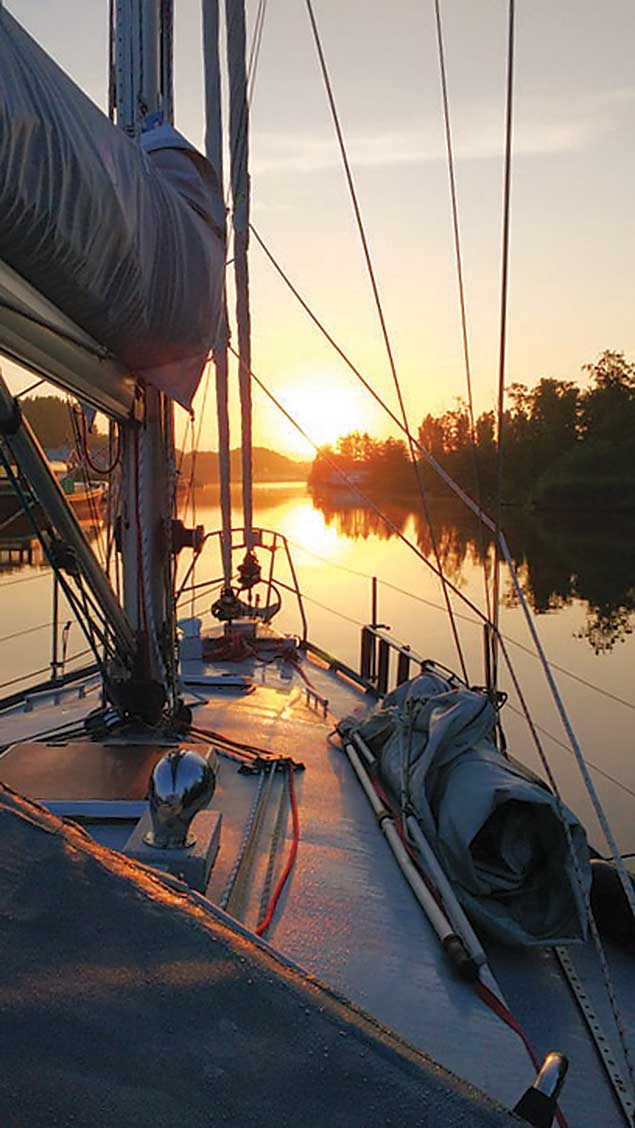 A long way from Pacific Islands. Dawn beyond the Ijsselmeer in the Netherlands, as seen from Pylades during the cruise to Russia. Photo: Fergus Quinlan.
A long way from Pacific Islands. Dawn beyond the Ijsselmeer in the Netherlands, as seen from Pylades during the cruise to Russia. Photo: Fergus Quinlan.
But then that world circuit saw Pylades being awarded the Faulkner Cup three years on the trot, so maybe there’s room for a new trophy “For A Cruise Which Is As Different As Possible From The Same Vessel’s Previous Award-winning Cruise”.
And then there’s no award for a cruise which provides photos which best capture the sprit of a cruising area, but for 2016 it would have gone to Paul Newport of Howth, whose cruise his wife Fiona to the Hebrides with the Najad 332 Puffin Eile was not only a gem of its type, but he brought back a couple of photos which make the place live for the rest of us.
The more dramatic is taken into the sun at Cragaig Bay on the island of Ulva west of Mull, with the distinctive Dutchman’s Cap island in the distance. In the foreground are four cruising yachts, all lying to their own anchors in the approved manner, all at a distance from each other which is enough for politeness and privacy, yet they’re not so far apart that there can’t be some sociable interchange if it is mutually wished.
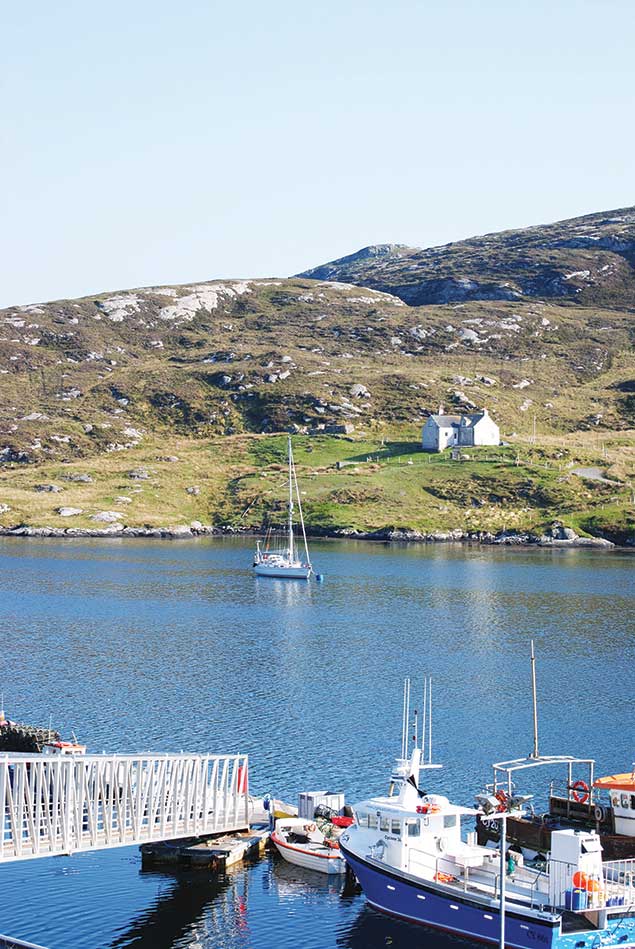 The most perfect small Hebridean island…..Puffin Eile at Eriskay. Photo Paul Newport
The most perfect small Hebridean island…..Puffin Eile at Eriskay. Photo Paul Newport
The other is simply Puffin Eile lying to the visitor’s mooring in the lovely little island of Eriskay. Eriskay is so perfect that when we first went there, one of my shipmates was so impressed that he duly named his next boat after it. Yet somehow timetables in cruising the Outer Hebrides recently have meant that we’ve missed out on Eriskay while passing south or north through the Sea of the Hebrides, so it’s good to see the little place looking so well.
Getting a special satisfaction out of sailing your own boat to places like Eriskay is part of what cruising is all abut. But there are many other factors which contribute to true enjoyment of this mainstream yet low-profile aspect of sailing, and one of them is good food.
So it’s a brilliant idea that Rachel Allen of Ballymaloe should be another of the key speakers at today’s Cruising Conference in Cork. Only recently she featured here in Afloat as Olympic Silver Medallist Annalise Murphy has been doing the intensive 12-week Cookery Course at Ballymaloe, which is definitely not an undertaking for the faint-hearted.
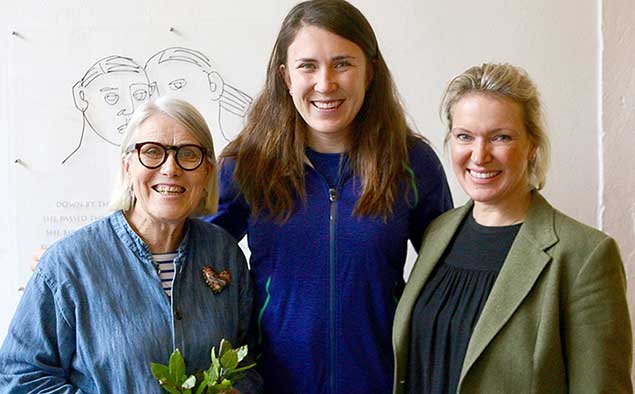 Darina Allen, Olympic Silver Medallist Annalise Murphy, and Rachel Allen at Ballymaloe Cookery School.
Darina Allen, Olympic Silver Medallist Annalise Murphy, and Rachel Allen at Ballymaloe Cookery School.
But Ballymaloe’s connections with sailing are much wider than that, for it was windsurfer Rory Allen of Ballymaloe, who started the famous Round Great Island Race in Cork Harbour scheduled at the top of the tide, and it’s now an annual highlight. And Rachel herself is of the O’Neill sailing family, whom we’ve known afloat for many years. It goes back a very long time to when they’d the Nicholson Half Tonner Silver Mite, and we buddy-boated together from West Cork home to Dublin in good company with Denis and Brian O’Neill. The latter very obligingly hauled one of the Nixon kids out of Kinsale Marina when he fell in while being over-enthusiastic about fishing. I’m happy to tell “Disgusted of Dunmanway” that the young fisherman was wearing a lifejacket, but the O’Neill pull-up was very much appreciated nevertheless.
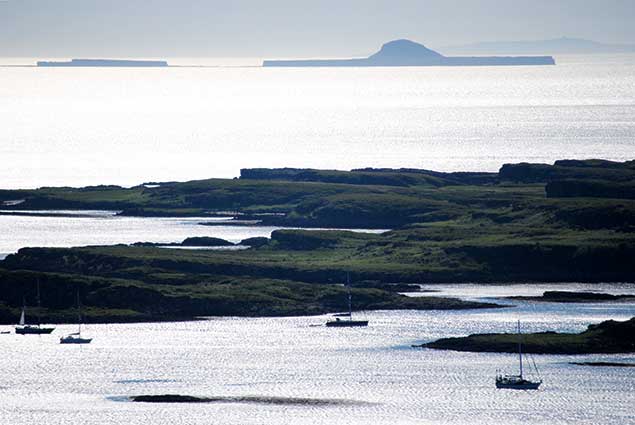 The cruising dream on Scotland’s West Coast. The anchorage at Cragaig Bay on Ulva off the west coast of Mull, with the distinctively-shape Dutchman’s Cap island beyond. Photo Paul Newport
The cruising dream on Scotland’s West Coast. The anchorage at Cragaig Bay on Ulva off the west coast of Mull, with the distinctively-shape Dutchman’s Cap island beyond. Photo Paul Newport
Sir Dennis Faulkner 1926-2016
One of the most noted sailing figures in Northern Ireland, Sir Dennis Faulkner died peacefully at his home close along the shore beside the hidden waters of Ringhaddy Sound in Strangford Lough at the age of 90 on New Year’s Eve.
Although in the public eye he may have been best known as the younger brother of Brian Faulkner, who was five years his senior and was Prime Minister of Northern Ireland in the early 1970s, while Dennis cherished his privacy he was active in voluntary naval and military service. This was in addition to being a leading businessman associated with several major companies, and he was also a very keen sailing enthusiast from childhood.
His boyhood was spent on the shores of Ballyholme Bay on Belfast Lough, and at an early age he showed his capacity to combine the skills of a seaman with the acumen of a considerable business talent. Spotting a dinghy drifting out of the bay in a strong offshore wind with the crew unable to cope with the conditions, he quickly effected a rescue. Yet by the time he was being praised by the local newspaper as “the schoolboy hero”, he personally was busy with pursuing an insurance claim for the salvage of the boat.
This combination of sailing ability with a businesslike approach to life was inherited from his father Jimmy Faulkner, who built up a commercial empire in Northern Ireland based initially on shirt manufacture, successfully maintaining contacts throughout Ireland and abroad both for business and sport. Thus when the first list of Irish Cruising Club members was compiled in 1930 after the club’s foundation in the summer of 1929, Jimmy Faulkner was on that inaugural list as owner of the 12-ton cutter Bryden.
 Dennis Faulkner’s spiritual home, where he built his dream house and off it moored a succession of fine yachts
Dennis Faulkner’s spiritual home, where he built his dream house and off it moored a succession of fine yachts
Later, in the summer of 1930, he went to his favourite cruising area, the West Coast of Scotland, in company with the new ICC’s first Commodore, Herbert Wright of Dun Laoghaire with his 15-ton cutter Espanola. Soon afterwards, Jimmy Faulkner presented the Irish Cruising Club with its first trophy, the Faulkner Cup. This led to the annual log competition which was instituted in 1931, and today it is the senior Irish cruising award, still competed for annually by boats and crews who have been to every corner of the world.
Initially, while young Dennis crewed from time to time with his father, racing was his primary interest, and he was seldom without a boat in one of the north’s leading One-Design classes. Much of his sailing focus had moved to Strangford Lough where he was involved with the River and Glen classes at Whiterock, but as he continued to live near the shores of Belfast Lough he also played an active role in the introduction of the Squib Class at Royal North of Ireland YC at Cultra.
However, when time permitted he participated in major international RORC events through a friendship with Geoffrey Pattinson who was best known for ownership of the successful Robert Clark-designed 55ft alloy sloop Jocasta , built 1950. With boats like this, Dennis Faulkner not only logged many ruggedly-raced offshore miles including several Fastnets, but he also built up a network of useful acquaintances who appreciated his toughness in hard-driving ocean conditions. As a result, he must have been one of the few people in all Ireland who had taken part in what used to be a southern hemisphere classic, the Buenos Aires-Rio de Janeiro Race.
In home waters, he also registered a win in a southwest gale as sailing master aboard a friend’s boat in the RUYC’s annual Ailsa Craig Race, but although he owned a succession of fine cruiser-racers, he was too fond of them to drive them to the uttermost in heavy weather. And having succeeded his father into membership of the Irish Cruising Club in 1960, the Hebrides continued to be the Faulkner family’s favourite cruising ground, where in time his liking for the Outer Hebrides was such that he bought a remote cottage on the shores of Loch Mariveg on the east coast of Lewis south of Stornoway. Any cruising enthusiasts who happened to find their way to this extremely secret spot found a very relaxed and hospitable Dennis Faulkner who had for the time being shed the cares of life back in Northern Ireland.
Inevitably his administrative talents were such that he joined the Irish Cruising Club Committee, and in 1969 he became Commodore ICC. At this stage his pet boat was the 49ft Robert Clark-designed Zest of Strangford, a hull-sister of Denis Doyle’s first Moonduster. The new Commodore ICC sailed Zest to Crosshaven to join the 1969 Cruise-in-Company of the leading cruising clubs – including a large Transatlantic contingent from the Cruising Club of America – as the opening salvo of the two year celebration of the Quarter Millennium of the Royal Cork Yacht Club.
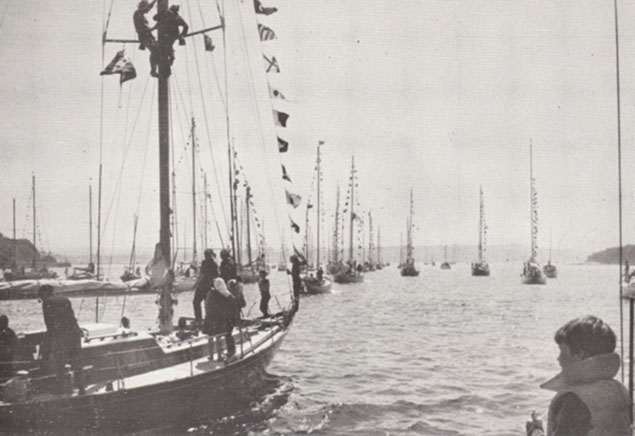 The Cruise-in-Company fleet in the Parade of Vessels in Cork Harbour which started the Royal Cork Yacht Club’s Quadrimillennial celebrations in 1969. Photo courtesy ICC
The Cruise-in-Company fleet in the Parade of Vessels in Cork Harbour which started the Royal Cork Yacht Club’s Quadrimillennial celebrations in 1969. Photo courtesy ICC
While voyaging to Cork, Zest had taken in tow a motor-boat with a broken-down engine. Whether or not this strained her own engine installation can only be guessed at, but during the Quadrimillennial Parade of Vessels under power round Cork Harbour – reviewed by An Taoiseach Jack Lynch – it was arranged that Zest would tow the engine-less Moonduster, and a problem occurred.
All was going well, the sun shone, the colours fluttered in the breeze, but then Zest’s propeller shaft fractured under the added load. However, Richard Nye’s famous 48ft Carina – then brand new and fresh in from racing Transatlantic – was next in line, and she took the two immobilised Irish boats in tow in such a smooth exercise that, as the two Dennises subsequently remarked, anyone watching assumed it was a pre-arranged and carefully-rehearsed part of the Parade.
That astonishing large-scale Cruise-in-Company – the first such in Irish waters - culminated in Glengarriff with a massive party at exactly the time the first American astronauts walked on the moon. It now all seems a very distant time ago, and in the long interval since, Dennis Faulkner never lost his love of sailing, while his fondness for Strangford Lough was eventually fulfilled by being able to build his dream home, a gently-styled house which blends well with its peaceful surroundings, on the shore of his beloved Ringhaddy Sound.
There, the Faulkner family showed what could be done in harmony with the environment, and his daughter and son-in-law have emerged among County Down’s leading horticulturalists. Dennis meanwhile continued his discerning pattern of cruising yacht ownership, his final serious voyaging craft being an Amel Super Maramu 54 ketch, a long way indeed from his father’s old clinker-built Scottish-style double-ender Bryden.
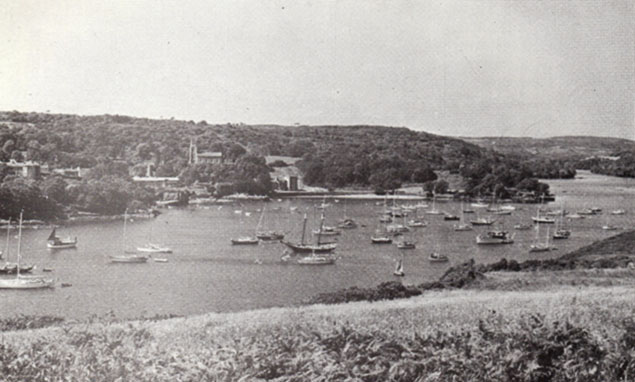 The 1969 Cruise-in-Company in Castlehaven – the schooner is Integrity (CCA). The cruise concluded in Glengarriff at the end of July when the American astronauts first walked on the moon. Photo courtesy ICC
The 1969 Cruise-in-Company in Castlehaven – the schooner is Integrity (CCA). The cruise concluded in Glengarriff at the end of July when the American astronauts first walked on the moon. Photo courtesy ICC
The family involvement with the cruising community worldwide - and particularly in Ireland - continued, and it was way back in 1970 that Dennis Faulkner found himself faced with the task of adjudicating the ICC logs, a process which had been started by his father’s presentation of the Faulkner Cup in 1931.
In honour of this, and in acknowledgement of the growth of the club and its activities since, he inaugurated a new trophy, the Strangford Cup for “an alternative best cruise”, which he duly awarded for 1970 to Rory O’Hanlon of Dun Laoghaire for his cruise to the Lofoten Islands in northern Norway with his S&S sloop Clarion.
Dennis Faulkner’s greatest enjoyment lay in interacting with the sea, in its most open form when he was in his prime, and in the intimate waters of Strangford Lough as the years moved on. He never lost his adventurous spirit, and on sailing through Ringhaddy Sound one day, we were much impressed by seeing the man himself out for a quick spin on a windsurfer. His final boat was Whimbrel, a Hawk day-sailer, and with her he rounded out a very complete life afloat. Our thoughts are with his family and many friends in their sad loss.
WMN
Joe Fitzgerald 1922–2016
Joe Fitzgerald of Cork went from among us a month and more ago at the age of 94. That month provides us with an added perspective for a full appreciation of his well-lived life afloat and ashore. It enhances our understanding of just how completely land and sea can become happily intertwined in life around Cork Harbour and city.
When that way of life is being lived by someone with Joe’s quiet yet always enthusiastic appreciation of the opportunities for good times in the world of boats and sailing, we find we’re looking at a long life which was a gentle inspiration and encouragement to all who knew him.
He seemed to find the perfect balance between running a demanding yet fulfilling business in the fashionable heart of Cork city, and relaxing through sailing and the company of sailing folk. The family firm in which he succeeded his father was the iconic Fitzgerald menswear, a tailoring and clothing company and shop which Joe elevated to such a reputation for quality in all areas that it’s said the young Louis Copeland, that legend of men’s tailoring, readily travelled from Dublin in order to enhance his skills by working with Joe Fitzgerald, learning from his notable eye for fabric and finish.
All these skills were allied to an astute yet very proper business aptitude. Nevertheless a good week’s work would be celebrated at its conclusion in proper style with a host of such quiet charm that when you found yourself relaxing after business hours in Joe’s company in the heart of Cork city, the sense of being in the midst of true civilisation was central to the mood of the evening, and that mood of generous enjoyment would then be carried on to the weekend’s projects in and around boats and sailing.
Despite his small stature - it’s thought that it was his longtime friend Stanley Roche who first called him “The Tiny Tailor”, though others in Cork will claim it was a northern friend – Joe was a tower of strength around boats, and he first acquired his sailing skills through spending his boyhood summers with an uncle who had a Brixham trawler converted to a sailing cruiser, and based in Crosshaven.
Although during his working years his family home was in Blackrock, Crosshaven remained his sailing home for the rest of his long life, and for his final decade he was a resident of the apartments which had been developed in the former Grand Hotel just across the road from the side door to the Royal Cork Yacht Club, where he was wont to meet his special circle of friends.
This link to shore living in Crosshaven went back to the late 1930s when Joe and some young contemporaries rented a house in the village on a year-round basis. They became much involved with the local dinghy sailing scene through the Cork Harbour Sailing Club, where the inspiration was top international helm Jimmy Payne, who saw to it that the club had a fleet of International 12 sailing dinghies available for charter at 10 shillings for half a day at a time when The Emergency engendered by World War II might have made access to sailing difficult
 The International 12s racing at Crosshaven in the 1940s. Photo courtesy RCYC
The International 12s racing at Crosshaven in the 1940s. Photo courtesy RCYC
Soon, a core of useful dinghy sailing experience built up. But by 1943 the waters around neutral Ireland were less directly affected by the war, and the Irish Cruising Club organised a race from Crosshaven around the Fastnet. Lest this seem callous at a time when war was still being waged, it should be noted that several naval and military officers on active service with the Allied forces managed to arrange leave in order to participate.
Among the boats taking part was the famous Gull from Crosshaven, one of the seven participants in the first international Fastnet Race of 1925. Although her legendary skipper Harry Donegan had died in 1940, his son Harry Jnr continued the family ownership of Gull, and for that race of 1943, he included the young Joe Fitzgerald in the crew. As a result, Joe Fitzgerald was elected a member of the Irish Cruising Club in 1944 on the proposal of Harry Donegan Jnr, and today the Fitzgerald ICC membership of 72 years has the air of the eternal record to it.
 The Donegan family’s Gull, a veteran of the first international Fastnet Race of 1925, aboard whch Joe Fitzerald qualified for Irish Cruising Club membership in 1944. Photo: Courtesy RCYC
The Donegan family’s Gull, a veteran of the first international Fastnet Race of 1925, aboard whch Joe Fitzerald qualified for Irish Cruising Club membership in 1944. Photo: Courtesy RCYC
Joe Fitzgerald was also busy in 1944 in other ways afloat, as he was continuing to play a key role in the dinghy sailing of the Cork Harbour Sailing Club, and 1944 saw the first races by CHSC in International 12s against Sutton Dinghy Club for “The Book”, the monumental volume in which each year’s racing is recorded by the winning team. It continues today with Sutton DC still in the picture, but it’s the mighty Royal Cork Yacht Club itself which now represents Cork Harbour, and has done so since 1970. Nevertheless it was a surprise for participants in 1988’s event in Crosshaven when Joe Fitzgerald was asked to speak at the dinner, and he gave his typically dry-humoured account of the racing in 1944 all of 44 years previously and waxed enthusiastic about the goodwill which The Book has generated ever since.
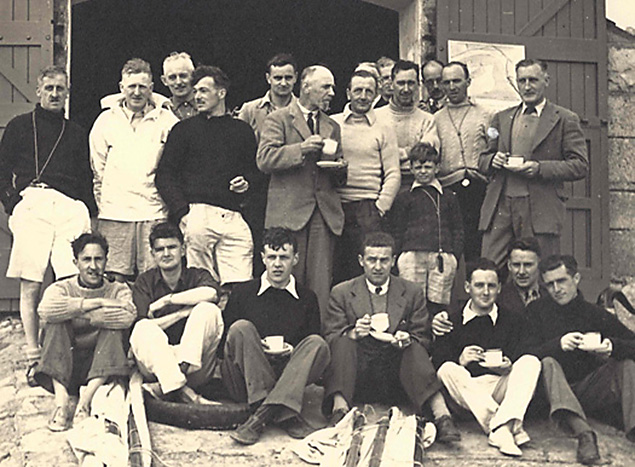 The teams racing for “The Book” at Sutton Dinghy Club in 1944. Joe Fitzgerald, on the Cork Harbour SC team, is third from the right of those seated at front. Photo courtesy SDC/RCYC
The teams racing for “The Book” at Sutton Dinghy Club in 1944. Joe Fitzgerald, on the Cork Harbour SC team, is third from the right of those seated at front. Photo courtesy SDC/RCYC
In addition to sailing for sport, Joe Fitzgerald in the 1940s joined the Maritime Inscription, continuing with the voluntary naval reserve which was re-formed as An Slua Muiri after the war. He recalled that his commissioning papers were signed by Eamonn de Valera himself, and his career with the force went on for 39 years. It’s said that he was within weeks of serving for forty years, but the stipulated retirement age was upon him. His many friends and colleagues hoped that the bureaucrats might stretch the rules just a tiny bit to allow him see out the forty years, but the bureaucracy was not for budging. Nevertheless Joe could retire from his many years of service knowing that he had been the youngest Commanding Officer of any region in Ireland.
Meanwhile he had long since been involved in sailing administration, having become Honorary Secretary of Cork Harbour Sailing Club in 1946 while also being an active member of the Royal Munster YC in Crosshaven. There was change in the air, and very suddenly in the late 1940s the International 12s, the backbone of Irish dinghy sailing for many years, found themselves being rapidly displaced by new boats such as the Fireflies and IDRA 14s in Dublin Bay, and the IDRA 14s and National 18s in Cork Harbour.
Joe opted for a George Bushe-built IDRA 14, and soon showed his mettle by winning the IDRA 14 Nationals at Dunmore East in 1951 in his new Mystery, crewed by Michael Donnelly. He was also crewing increasingly on larger craft, both for offshore racing and cruising. But when his father died suddenly at the age of 49 of a heart attack he had to re-direct energies into the family business.
It was a salutary lesson for him, as thereafter, while he was undoubtedly enjoying the good life with a high level of conviviality with a special coterie of close friends, he was way ahead of his time in keeping himself fit. His health regime - which he continued to the end of his days - included a cycling machine in a spare room in the house, and a programme of exercises which saw regular press-ups until well into his nineties.
Yet with a family on the way with his wife Maddie, he seemed the ordinary unfussed successful Cork businessman with a taste for sport and particularly sailing. In the 1960s, in addition to sailing on larger boats with top skippers such as Denis Doyle and Tom Crosbie, he got involved with the lively International Dragon Class which was growing at Crosshaven.
Almost all the boats in it were classic Scandinavian-built Dragons, but Joe decided he’d have his one built at Denis Doyle’s Crosshaven boatyard by the hugely-skilled George Bushe, who had already built his winning IDRA 14 Mystery.
George Bushe made a very good job of building the new Dragon class Melisande. In fact, he made too good a job of it. When the official measurer arrived over in Ireland to approve Melisande, he pointed out that as the Dragon was conceived as a basic economical boat, the frames were meant to have a simple rectangular section. Yet George in his love of providing a good finish had rounded off the exposed edges of the frames. The measurer was not for turning. Melisande would not be recognised as a true Dragon until the fancy rounded frames were replaced by crude hard-sectioned timbers. It was done. But it took a long time to obliterate the memory of having to do so.
Yet Joe’s time was successful in the Dragons, and he well-represented the Cork fleet in a major international event hosted at Crosshaven in 1962, coming third against the likes of winner Jock Workman from Belfast Lough and runner-up J L F Crean from the Solent.
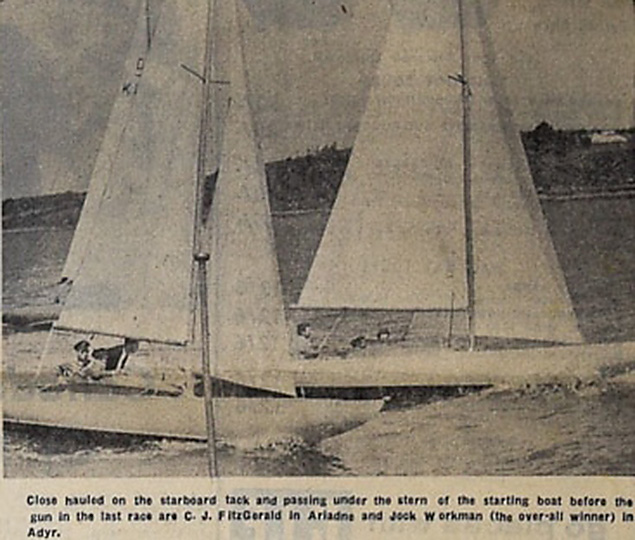 A photo from the Cork Evening Echo in 1962. The International Dragon Series at Crosshaven, with Joe Fitzgerald sailing for Cork Harbour (foreground) getting the better of eventual overall winner Jock Workman of Belfast Lough at the start
A photo from the Cork Evening Echo in 1962. The International Dragon Series at Crosshaven, with Joe Fitzgerald sailing for Cork Harbour (foreground) getting the better of eventual overall winner Jock Workman of Belfast Lough at the start
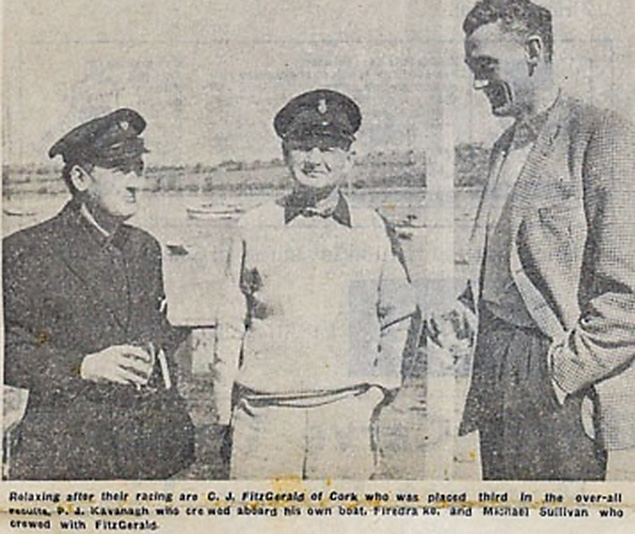 At the 1962 Dragon Open Series are skipper Joe Fitzgerald (left) with his crew of P J Kavanagh and Mick Sullivan
At the 1962 Dragon Open Series are skipper Joe Fitzgerald (left) with his crew of P J Kavanagh and Mick Sullivan
But increasingly he found most pleasure in cruiser-racers, and he teamed up with longtime friend Peter Cagney to order a new Cuthbertson & Cassian-designed Trapper 28, finished on a bare glassfibre hull by George Bushe at his new yard at Rochestown. It was now that Joe Fitzgerald really began to spread his wings, and every possible free moment was used for cruising, though their explorations were not without the occasional mishap.
Approaching Courtmacsherry long before it was a popular port of call, Peter was below and Joe was at the helm when they lightly clipped a rock. In response to the roar from below, the helmsman blithely replied: “Your half of the boat has just struck a rock, but it’s nothing serious……”
Building on experience over the years with his own boats and the larger vessels of friends, Joe Fitzgerald developed an entire philosophy of cruising in which he built up a complete matrix of friendly ports mostly on the Cork coast but also further afield and internationally too, and as well he showed how a place like Cork Harbour meant you could have a cruising weekend of some sort virtually regardless of what the weather might throw at you. And of course, if good conditions arrived, it was amazing what he could achieve by adding a day or two on to the beginning or the end of a favourable weekend.
To do this he maintained understanding friendships which provided lifelong bonds, and if other Cork sailors took to calling them “Dad’s Army”, Joe and his friends in turn showed a level of continuing love of boats and sailing which were inspirational to all. With such an approach, it was only natural that Joe Fitzgerald should be called upon to fill important roles in sailing administration, and while he could have his own way of doing things which was not always the way of other people, the very fact of his many sailing and cruising achievements often gave him carte blanche to continue the Fitzgerald administrative style, while his speeches at formal gatherings were gems to be treasured.
Thus having started at Honorary Secretary of Cork Harbour Sailing Club in 1946, he rose through many ranks, becoming Rear Commodore of the Royal Munster YC as long ago as 1949, and then when the Royal Munster and the Royal Cork merged during the late 1960s, the Royal Cork Quadrimillenial Celebrations of 1970 saw Joe in the key role of the still-extant position of Commodore which gave due recognition to the Royal Munster’s input, and then in 1975 he was RCYC Vice Admiral in support of George Kenefick as Admiral.
But it was in the Irish Cruising Club that the light-touch Fitzgerald management style proved most congenial. For many years he was on the Committee, by 1982 he was Vice Commodore, and he was then elected Commodore by acclamation from 1984 to 1986, heading the club with his calming presence at a time of rapid development.
Meanwhile his boat sizes had gently increased, and they reflected the reality of the needs of a sailor who continued in and around his boats afloat on a virtually year round basis. He moved up to a Moody 33 from the Trapper 28, and he was with that Moody 33 when we happened to drop into Youghal of a Saturday night in 1986 on our way to Cork Week in a 30-footer, and there was the Commodore ICC in fine form for a bit of a party, which duly took place.
By 1990 he’d moved on to a Moody Eclipse with its useful deckhouse, and we found ourselves in our little boat in Crosshaven waiting out a Sunday of filthy weather before better weather settled in to carry us south to Biscay. So Joe suggested that as he’d the deckhouse, we should go and spend the day with him on his boat over in East Ferry, and thus the bad weather was let go through without any interruption to the merriment, and next day we went on our way with a fair wind and sunshine, sustained by the entertaining memories of our thoughtful and imaginative clubmate back in Cork.
That’s the way it was with Joe Fitzgerald. He made the best of the hand that life dealt him. A widower since 1983, he still had 33 years to live, and he lived them with quiet enjoyment. He even decided he’d outgrown the Moody Eclipse, and bought himself a hefty Nauticat 33 which took on the Fitzgerald name of Mandalay, and provided an “all indoors” boat which enabled this most gallant senior sailor to continue his love affair with boats and the sea and boat people.
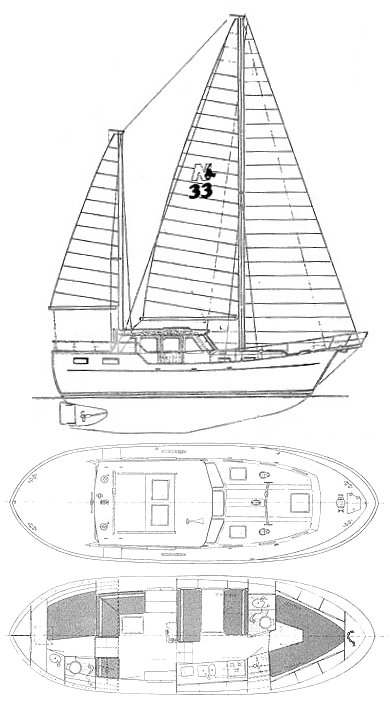 The “All Indoors” boat. The Nauticat 33 enabled Joe Fitzgerald to continue cruising until he’d become a very senior sailor.It is impossible to do full justice to Joe Fitzgerald in ordinary words. The world has been a much more interesting place for his having been in it. His view of life was unique. And his view of death was unusual. For his funeral service, he requested no more than a simple humanist ceremony. Yet we’re told one of the speakers with fond memories was a good old friend who was a former chaplain to the Naval Service at Haulbowline. In his quiet way, Joe Fitzgerald was beyond mere imagination, and he leaves family and friends with many cherished memories.
The “All Indoors” boat. The Nauticat 33 enabled Joe Fitzgerald to continue cruising until he’d become a very senior sailor.It is impossible to do full justice to Joe Fitzgerald in ordinary words. The world has been a much more interesting place for his having been in it. His view of life was unique. And his view of death was unusual. For his funeral service, he requested no more than a simple humanist ceremony. Yet we’re told one of the speakers with fond memories was a good old friend who was a former chaplain to the Naval Service at Haulbowline. In his quiet way, Joe Fitzgerald was beyond mere imagination, and he leaves family and friends with many cherished memories.
WMN
An exemplary three year Atlantic circuit sailing cruise was completed this weekend with the return to Ireland of Neil Hegarty’s Dufour 34 Shelduck from Cork. Shelduck has reached Baltimore in the last of the summer after a rugged 16–day west-east Transatlantic return crossing from Newfoundland writes WM Nixon. The voyage saw the veteran skipper and his crew coping with at least one Force 8 gale and a definite Force 9, but in all conditions he was happy to report that his well-proven ship “behaved impeccably”.
Shelduck visited many coasts, harbours and islands during her time on the other side of the Atlantic, and was awarded the Irish Cruising Club’s premier trophy the Faulkner Cup, for 2014, while Neil Hegarty was also an Afloat.ie “Sailor of the Month” for February 2015. He is noted for the high quality of information provided with his logs, and for his careful planning to make time available for detailed local cruising by laying up the boat in North America for two winters. As well, as his cruising partner Anne Kenny of Tralee had the 36-footer Tam O’Shanter in the Baltic, parts of the cruising season in the Northern Hemisphere were given over to Scandinavian ventures.
However, for 2016 and the final summer in America, Neil and Anne joined Shelduck in Southwest Harbor, Maine on June 1st, and cruised extensively around North Maine, New Brunswick, Nova Scotia, Labrador, and Newfoundland. Then in Lewisporte in Newfoundland, they made the final preparations for the Transatlantic crossing to start in mid-August, and strengthened their crew with the addition of Neil’s son Paul – who’s an electronics and communications ace – and Charlie Kavanagh, whom the skipper describes as “a very good foredeck hand, Anne and I stuck to the cockpit…….”
During the summer of 2016, the North Atlantic was in a decidedly restless condition for much of the time, and though Paul Hegarty’s communications network during the crossing ensured that they minimised their contact with bad weather, there were some storms that just coudn’t be avoided. Yet this well-found boat and her experienced crew came through with flying colours.

Drogheda Port Company welcomed the Irish Cruising Club Rally to Drogheda on the weekend of Saturday 4th June for the first time in 41 years. The club last visited Drogheda in September 1975. The recent promotion and popularity of the river Boyne and the Irish Maritime Festival as key tourist attractions for visiting leisure boats was fundamental in attracting the club back to the Boyneside to have their annual rally.
The club visit consisting of 17 yachts and 60 visitors arrived from all parts of Ireland, north and south and were welcomed into the port on saturday morning on the high tide by the acting port Chairperson Gail McEvoy. The yachts were accommodated on the steampacket quay inside the town port.
Specially designed Drogheda burgees, with the eight pointed star and crescent from the port emblem of 1770, were presented to the captain of each of the visiting yachts as a memento of their visit by acting port chairperson Gail McEvoy, to spread the word to the yachting community that Drogheda is open to leisure tourism.
A welcoming hamper was also put on board each of the visiting yachts with samples of the best of local produce. The port company wishes to acknowledge the generous involvement of Dan Kelly’s Cider, Jack Cody’s Beer, Boyne Valley Foods, East Coast Bakehouse, Clarkes Fresh Fruit and Gerry’s Fresh Food, all playing their part to promote the region through Corporate Social Responsibility initiatives such as this.
The visitors had a full itinerary organised for their stay and enjoyed the historic town with a walking tour arranged through the Old Drogheda Society and finishing with an evening meal in the town centre.
Tom Fitzpatrick Rally Captain thanks Drogheda port for the warm welcome the club received from Drogheda Port and commented on the lovely sail into Drogheda along Boyne which had surpassed everyone’s expectations. He presented a copy of the club burgee and annual from 1975 commemorating the last time the club visited.
Paul Fleming Drogheda Port CEO in welcoming the visitors agreed with the rally Captain that the most attractive way to arriving to Drogheda is on the Boyne on a sunny day, a pleasure few people get to experience, but thankfully this is changing. He also thanked the local food producers who all contributed to extending a local welcome which will be remembered.
The club was founded in 1929 and initially arranged offshore races as well as cruising activities and into the 1960s was organising the Irish Admiral’s Cup teams for their biennial foray to Cowes. Since the 1970s the focus of the club has been to promote cruising under sail and to provide publications and services for members and for the cruising community.
The ultimate dreamworks for those who cruise the Irish coast, or indeed those who just hope to do so one day, has been reaching distributors and subscribers this week with the 14th Edition of the Irish Cruising Club’s Sailing Directions for the South & West Coasts of Ireland coming hot off the press writes W M Nixon.
It’s only three years since the 13th Edition was published, but as Ireland emerges from recession, new harbour developments are taking place. And as well, Honorary Editor Norman Kean, ably assisted by his wife Geraldine Hennigan, is constantly up-dating information, and receiving input from ICC members and other interested folk in all sorts of out of the way places, adding to the already enormous shared stock of top class local knowledge about harbours and anchorages large and small.
The book is available to purchase directly from distributors Todd Navigation via the Afloat marketplace here.
In this age of electronic navigation, it may surprise some that there is a continuing demand for new editions of a book which was first compiled by the great Harry Donegan of Cork in 1930, and he in turn had been collating information, and making harbour charts aimed at the needs of cruising enthusiasts, since 1912.

With clear chartlets like this, the ICC makes secret anchorages such as Golam Harbour on the south coast of Connemara accessible to cruising folk from other areas. Courtesy ICC
But in fact this history going back more than a hundred years is part of the book’s attraction. And despite today’s gadgetry, no serious cruising person would contemplate heading off for a detailed venture along the Irish coast without a copy of it on board.
The mixture of technical information well leavened with clear charts and evocative photographs has improved steadily over the years, and the Foreword from Roger Millard, the recently-retired Regional Geographic Manager at the Admiralty Hydrographic Office, neatly encapsulates the high regard in which the ICC Directions are held, as he comments: “Although aimed at small-craft users, it has many admirers from major maritime institutions”.
His Foreword’s conclusion provides a warmth of support beyond professional admiration. Having listed the Directions’ special features of invaluable assistance to small craft users, he concludes: “On top of these advantages, I find it a fascinating read, and I am sure you will enjoy it”.

Goleen in far West Cork is known as a port of call to very few, even though the holiday traffic to Barleycove and Crookhaven barrels through the village every day. Courtesy ICC
While those of us who have cruised the coastlines involved many times will find pleasure in visiting old haunts as they now appear, one of two places where the new book has seen detailed fresh research have been that strange unknown area between Achill Island and Belmullet, a large yet secret location where the noted smuggler Captain James Mathew from Rush in Fingal used to anchor his ship in the 1830s, and small craft would emerge from every nook and cranny nearby. Those aboard each currach would be carrying dockets bought from Mathew’s agents ashore which, once they reached the ship, they could exchange for punitively taxed goods without any money actually changing hands. It was all extremely businesslike, yet the legendary Captain Mathews was chased to his destruction by the Revenue cutters off Donegal in an October storm.
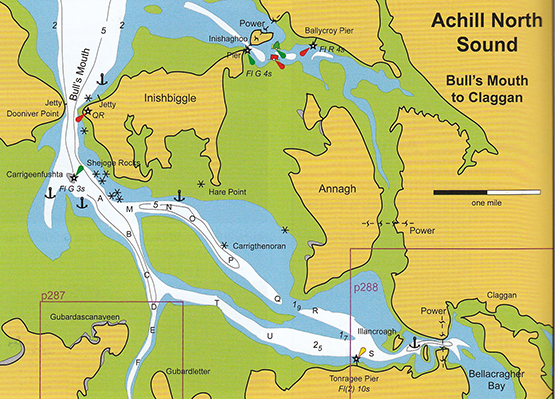
The northern area of Achill Sound is one of the areas re-surveyed for the new Sailing Directions, and some previously unlisted anchorages have been detailed. Courtesy ICC
The other area getting the special Keane-Hennigan update is the south coast, eastward of Cork. Regular Afloat.ie visitors recently will be aware of the remarkable photo of Blind Harbour on the Waterford coast which they obtained with their Warrior 40 Coire Uisge anchored in this extraordinary gap in the cliffs. But as this coastline is much transitted by the large fleets from the East Coast trying to reach the promised cruising land of the Southwest, the good news is that Dunmore East is dredged and looking forward to further developments which will be more friendly to recreational boat users, Kilmore Quay is better run than ever, a real trophy facility for Wexford County Council, and even the utterly utilitarian ferry port of Rosslare – sometimes a crucial facility for small craft trying to negotiate Ireland’s tricky southeast corner – has been showing a friendlier attitude to boats in need in recent summers.
And yes, I know that strictly speaking Rosslare is not on the south coast, let alone the west coast. But the fact that it gets included shows the generously informative approach which the Editor and his team have taken with this fine book, which retails at €33.75.
Buy the book HERE
Irish Cruising Comes Centre Stage In Howth Yacht Club
With last night’s Irish Cruising Club Annual General Meeting & Prize-Giving hosted at Howth Yacht Club, and this morning’s day-long ISA Cruising Conference at the same venue, centre stage has been taken by the silent majority – the large but distinctly reticent segment of the sailing population which emphatically does not have racing as its primary interest afloat. W M Nixon takes us on a guided tour.
The great Leif Eriksson would approve of some of the more adventurous members of the Irish Cruising Club. They seem to be obsessed with sailing to Greenland and cruising along its coast. And it was the doughty Viking’s father Erik Thorvaldsson (aka Erik the Red) who first told his fellow Icelanders that he’d given the name of Greenland to the enormous island he’d discovered far to the west of Iceland. He did so because he claimed much of it was so lush and fertile, with huge potential for rural and coastal development, that no other name would do.
Leif then followed in the family tradition of going completely over the top in naming newly-discovered real estate. He went even further west and discovered a foggy cold part of the American mainland which he promptly named Vinland, as he claimed the area was just one potential classic wine chateau after another, and hadn’t he brought back the vines to prove it?
In time, Erik’s enthusiasm for Greenland was seen as an early property scam. For no sooner had the Icelanders established a little settlement there around 1000 AD than a period of Arctic cooling began to set in, and by the mid-1300s there’d been a serious deterioration of the climate. What had been a Scandinavian population of maybe five thousands at its peak faded away, and gradually the Inuit people – originally from the American mainland – moved south from their first beachheads established to the northwest around 1200 AD. They proved more successful at adapting to what had become a Little Ice Age, while no Vikings were left.
Now we’re in the era of global warming, and there’s no doubt that Greenland is more accessible. But for those of us who think that cruising should be a matter of making yourself as comfortable as possible while your boats sails briskly across the sea in a temperate climate or perhaps even warmer for preference, the notion of devoting a summer to sailing to Greenland and taking on the challenge of its rugged iron coast, with ice everywhere, still takes a bit of getting used to.
Yet in recent years the Irish boats seem to have been tripping over each other up there. And for some true aficionados, the lure of the icy regions was in place long before the effects of global warming were visibly making it more accessible.
Peter Killen of Malahide, Commodore of the Irish Cruising Club, is a flag officer who leads by example. It was all of twenty years ago that he was first in Greenland with his Sigma 36 Black Pepper, and truly there was a lot of ice about. The weather was also dreadful, while Ireland was enjoying the best summer in years.

Peter Killen’s Sigma 36 Black Pepper in local ice at the quay inside Cape Farewell in Greenland, August 1995

ICC Commodore Peter Killen’s current boat is Pure Magic, an Amel Super Maramu seen here providing the backdrop for a fine penguin in Antarctica, December 2004.
More recently, he and his crew of longterm shipmates have been covering thousands of sea miles in the Amel Super Maramu 54 Pure Magic, among other ventures having a look at lots more ice down Antarctic way to see how it compares with the Arctic. With all their wanderings, by the end of the 2014 season Pure Magic was laid up for the winter in eastern Canada in Nova Scotia. So of course in order to get back to Ireland through 2015, the only way was with a long diversion up the west coast of Greenland. And the weather was grand, while Ireland definitely wasn’t enjoying the best summer in years.
The Pure Magic team certainly believe in enjoying their cruising, however rugged the terrain. If the Greenland Tourist Board are looking for a marketing manager, they could do no better than sign up the skipper of Pure Magic for the job. His entertaining log about cruising the region – featured in the usual impressive ICC Annual edited for the fourth time by Ed Wheeler – makes West Greenland seem a fun place with heaps of hospitality and friendly folk from one end to the other.

If ice is your thing, then this is the place to be – Peter Killen’s Pure Magic off the west Greenland coast, summer 2015.
But then Peter Killen is not as other men. I don’t mean he is some sort of alien being from the planet Zog. Or at least he isn’t so far as I know. But the fact is, he just doesn’t seem to feel the cold. I sailed with him on a raw Autumn day some years ago, and while the rest of us were piling on the layers, our skipper was as happy as Larry in a short-sleeved shirt.
I’d been thinking my memory had exaggerated this immunity to cold. But there sure enough in the latest ICC Annual is a photo of the crew of Pure Magic enjoying a visit to the little Katersugaasivik Museum in Nuuk, and the bould skipper is in what could well be the same skimpy outfit he was wearing when we sailed together all those years ago. As for the rest of the group, only tough nut Hugh Barry isn’t wearing a jacket of some sort – even Aqqala the Museum curator is wearing one.
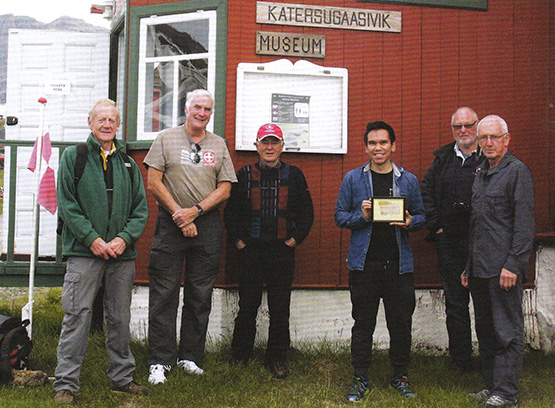
Some folk feel the cold more than others – Pure Magic’s crew absorbing local culture in Greenland are (left to right) Mike Alexander, Peter Killen, Hugh Barry, Aqqalu the museum curator, Robert Barker, and Joe Phelan
Having a skipper with this immunity to cold proved to be a Godsend before they left Greenland waters, when Pure Magic picked up a fishing net in her prop while motoring in a calm. Peter Killen has carried a wetsuit for emergencies for years, and finally it was used. He hauled it on, plunged in with breathing gear in action, and had the foul-up cleared in twenty minutes. Other skipper and Commodores please note……
The adjudicator for the 2015 logs was Hilary Keatinge, who has one of those choice-of-gender names which might confuse, so it’s good news to reveal that after 85 years, the ICC has had its first woman adjudicator. No better one for the job, man or woman. Before marrying the late Bill Keatinge, she was Hilary Roche, daughter of Terry Roche of Dun Laoghaire who cruised the entire coastline of Europe in a twenty year odyssey of successive summers, and his daughter has proven herself a formidable cruising person, a noted narrator of cruising experiences, and a successful writer of cruising guides and histories.
Nevertheless even she admitted last night that once all the material has arrived on the adjudicator’s screen, she finally appreciated the enormity of the task at hand, for the Irish Cruising Club just seems to go from strength to strength. Yet although it’s a club which limits itself to 550 members as anything beyond that would result in administrative overload and the lowering of standards, it ensures that the experience of its members benefit the entire sailing community through its regularly up-dated sailing directions for the entire coast of Ireland. And there’s overlap with the wider membership of the Cruising Association of Ireland, which will add extra talent to the expert lineup providing a host of information and guidance at today’s ISA Cruising Conference.
But that’s this morning’s work. Meanwhile last night’s dispensation of the silverware – some of which dates back to 1931 – revealed an extraordinarily active membership. And while they did have those hardy souls who ventured into icy regions, there were many others who went to places where the only ice within thousands of miles was in the nearest fridge, and instead of bare rocky mountains they cruised lush green coasts.
Nevertheless the ice men have it in terms of some of the top awards, as Hilary Keatinge has given the Atlantic Trophy for the best cruise with a passage of more than a thousand miles to the 4194 mile cruise of Peter Killen’s Pure Magic from Halifax to Nova Scotia to Howth, with those many diversions on the way, while the Strangford Cup for an alternative best cruise goes to Paddy Barry, who set forth from Poolbeg in the heart of Dublin Port, and by the time he’d returned he’d completed his “North Atlantic Crescent”, first to the Faeroes, then Iceland to port, then across the Denmark Strait to southeast Greenland for detailed cruising and mountaineering, then eventually towards Ireland but leaving Iceland to port, so they circumnavigated it in the midst of greater enterprises.
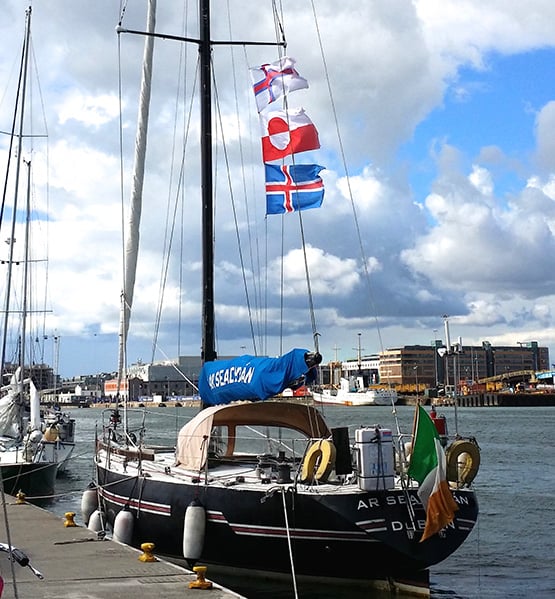
You collect very few courtesy ensigns in the frozen north. Back at Poolbeg in Dublin after her “North Atlantic Crescent” round Iceland and on to Greenland, Paddy Barry’s Ar Seachran sports the flags of the Faroes, Iceland and Greenland. Ar Seachran is a 1979 alloy-built Frers 45. Photo: Tony Brown
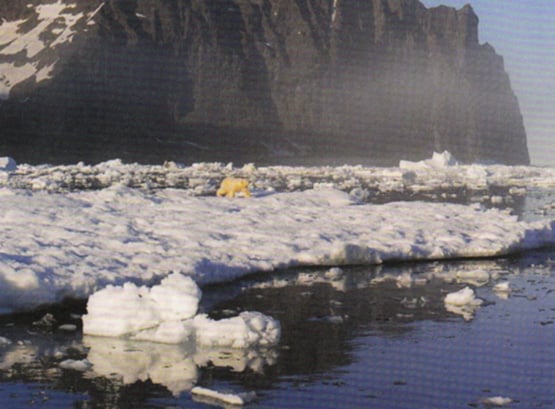
“Definitely the Arctic”. A polar bear spotted from Ar Seachran. Photo: Ronan O Caoimh
Paddy Barry started his epic ocean voyaging many years ago with the Galway Hooker St Patrick, but his cruising boat these days is very different, a classic Frers 45 offshore racer of 1979 vintage. Probably the last thing the Frers team were thinking when they turned out a whole range of these gorgeous performance boats thirty-five years ago was that their aluminium hulls would prove ideal for getting quickly to icy regions, and then coping with sea ice of all shapes and ices once they got there. But not only does Paddy Barry’s Ar Seacrhran do it with aplomb, so too does Jamie Young’s slightly larger sister, the Frers 49 Killary Flyer (ex Hesperia ex Noryema XI) from Connacht, whose later adventures in West Greenland featured recently in a TG4 documentary.
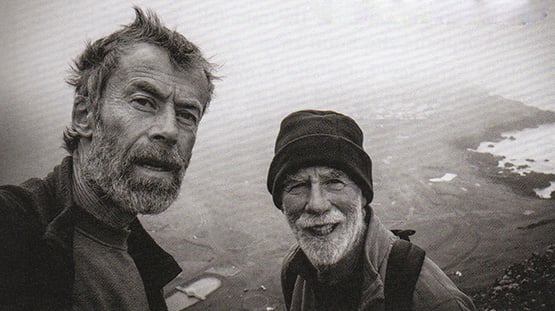
“A grand soft day in Iceland”. Harry Connolly and Paddy Barry setting out to take on mountains in Iceland during their award-winning cruise to Greenland. Photo: Harry Connolly
Pure Magic and Ar Seachran are hefty big boats, but the other ICC voyager rewarded last night by Hilary Keatinge for getting to Arctic waters did his cruise in the Lady Kate, a boat so ordinary you’d scarcely notice her were it not for the fact that she’s kept in exceptionally good trim.
Drive along in summer past the inner harbour at Dungarvan in West Waterford at low water, and you’ll inevitably be distracted by the number of locally-based bilge-keelers sitting serenely upright (more or less) on that famous Dungarvan mud. There amongst them might be the Moody 31 Lady Kate, for Dungarvan is her home port.
But she was away for quite a while last year, as Donal Walsh took her on an extraordinary cruise to the Arctic, going west of the British mainland then on via Orkney and Shetland to Norway whose coast goes on for ever until you reach the Artic Circle where the doughty Donal had a swim, as one does, and looked at a glacier or too, and then sailed home but this this time leaving the British mainland to starboard. A fabulous 3,500 mile eleven week cruise, he very deservedly was awarded the Fingal Cup for a venture the adjudicator reckons to be extra special – as she puts it, “you feel you’re part of the crew, though I don’t think I’d have done the Arctic Circle swim.”
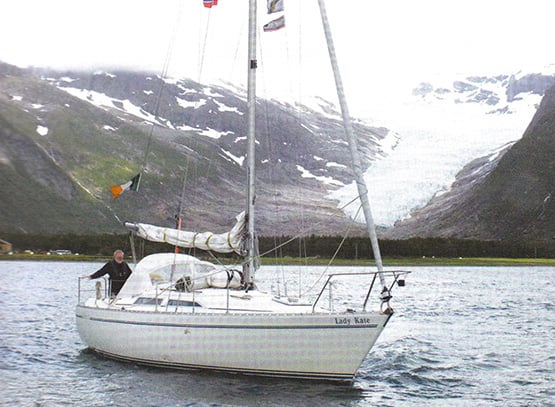
A long way from Dungarvan. Lady Kate with Donal Walsh off the Svartsen Glacier in northern Norway
Indeed, in taking an overview of the placings of the awards, you can reasonable conclude that the adjudicator reckons any civilized person can have enough of ice cruising, as she gives the ICC’s premier trophy, the Faulkner Cup, to a classic Atlantic triangle cruise to the Azores made from Dun Laoghaire by Alan Rountree with his van de Sadt-designed Legend 34 Tallulah, a boat of 1987 vintage which he completed himself (to a very high standard) from a hull made in Dublin by BJ Marine.
Tallulah looks as immaculate as ever, as we all saw at the Cruising Association of Ireland rally in Dublin’s River Liffey in September. And this is something of a special year for Alan Rountree, as completely independently of the Faulkner Cup award, the East Coast ICC members awarded their own area trophy, the Donegan Cup for longterm achievement, to Tallulah’s skipper. As one of those involved in the decision put it, basically he got the Donegan Trophy “for being Alan Rountree – what more can be said?”
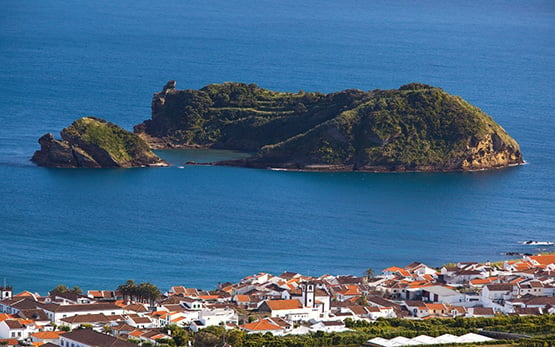
The essence of the Azores. Red roofs maybe, but not an iceberg in sight, and the green is even greener than Ireland. Alan Rountree’s succesful return cruise to the Azores has been awarded the ICC’s premier trophy, the Faulkner Cup.

Tallulah at the CAI Rally in the Liffey last Setpember. She looks as good today as when Alan Rountree completed her from a bare hull nearly thirty years ago. Photo: W M Nixon
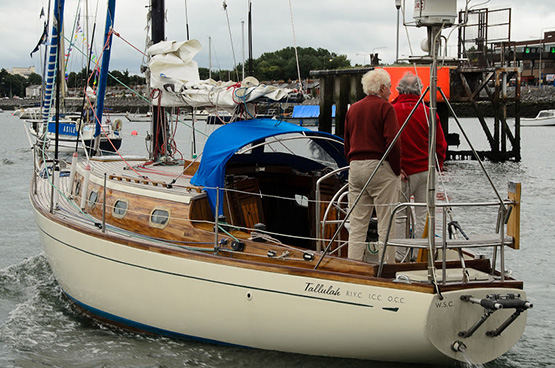
A boat to get you there – and back again. Tallulah takes her departure from the CAI Rally in Dublin. Photo: Aidan Coughlan
Well, it can be said that his Azores cruise was quietly courageous, for although the weather was fine in the islands, the nearer he got to Ireland the more unsettled it became, and he sailed with the recollection of Tallulah being rolled through 360 degrees as she crossed the Continental Shelf in a storm in 1991. But he simply plodded on through calm and storm, the job was done, and Tallulah is the latest recipient of a trophy which embodies the history of modern Irish cruising.
There were many other awards distributed last night, and for those who think that the ICC is all about enormous expensively-equipped boats, let it be recorded that the Marie Trophy for a best cruise in a boat under 30ft long went to Conor O’Byrne of Galway who sailed to the Hebrides with his Sadler 26 Calico Jack, while the Fortnight Cup was taken by a 32-footer, Harry Whelehan’s Jeanneau Sun Odyssey 32 for a fascinating cruise in detail round the Irish Sea, an area in which, the further east you get to coastlines known to very few Irish cruising men, then the bigger the tides become with very demanding challenges in the pilotage stales.
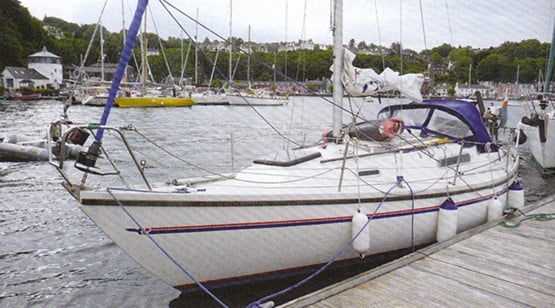
The smallest boat to be awarded a trophy at last night's Irish Cruising Club prize-giving was Conor O’Byrne’s Sadler 26 Calico Jack, seen here in Tobermory during her cruise from Connacht to the Hebrides
As for “expensively equipped”, the Rockabill Trophy for seamanship went to Paul Cooper, former Commodore of Clontarf Yacht & Boat Club and an ICC member for 32 years, who solved a series of very threatening problems with guts and ingenuity aboard someone else’s Spray replica during a 1500 mile voyage in the Caribbean, with very major problems being skillfully solved, as the judge observed, “without a cross word being spoken”.
Not surprisingly in view of the weather Ireland experienced for much of the season, there were no contenders for the Round Ireland cruise trophy, though I suppose you could argue that the return of Pure Magic meant the completion of a round Ireland venture, even if in this case the Emerald Isle becomes no more than a mark of the course.
In fact, with the unsettled weather conditions of recent summers in Ireland , there’s now quite a substantial group of ICC boats based out in Galicia in northwest Spain, where the mood of the coast and the weather “is like Ireland only better”. The ICC Annual gives us a glimpse of the activities of these exiles, and one of the most interesting photos in it is provided by Peter Haden of Ballyvaughan in County Clare, whose 36ft Westerly Seahawk Papageno has been based among the Galician rias for many years now.
Down there, the Irish cruising colony can even do a spot of racing provided it’s against interesting local tradtional boats, and Peter’s photo is of Dermod Lovett of Cork going flat out in his classic Salar 40 Lonehort against one of the local Dorna Xeiteras, which we’re told is the Galician equivalent of a Galway Bay gleoiteog. Whatever, neither boat in the photo is giving an inch.
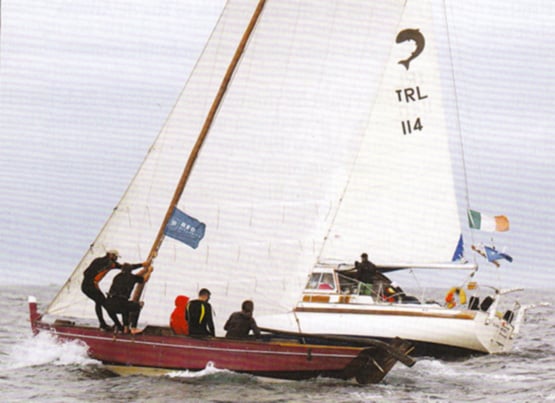
So who never races? Dermod Lovett ICC in competition with his Salar 40 Lonehort against a local traditional Dorna Xeiteira among the rias of northwest Spain. Photo: Peter Haden
Hilary Keatinge’s adjudication is a delight to read in itself, and last night after just about every sailing centre in Ireland was honoured with an ICC award for one of its locally-based members, naturally the crews leapt to the mainbrace and great was the splicing thereof.
But it’s back to porridge this morning in HYC and the serious work of the ISA Cruising Conference, where the range of topics is clearly of great interest, for the Conference was booked out within a very short time of being highlighted on the Afloat.ie website.
It’s during it that we’ll hear more about that intriguing little anchorage which provides our header photo, for although it could well be somewhere on the Algarve in Portugal, or even in the Ionian islands in Greece were it not for the evidence of tide, it is in fact on the Copper Coast of south Waterford, between Dungarvan and Dunmore East, and it’s known as Blind Harbour.
It’s a charming place if you’ve very settled weather, but it’s so small that you’d probably need to moor bow and stern if you were thinking to overnight, but that’s not really recommended anyway. Norman Kean, Editor of the Irish Cruising Club Sailing Directions, had heard about this intriguing little spot from Donal Walsh of Dungarvan (he who has just been awarded the Fingal Cup), and being Norman Kean, he and Geraldine just had to go and experience it for themselves. But it has taken three attempts to have the right conditions as they were sailing by, and it happened in 2015 in a very brief period of settled weather as they headed past in their recently-acquired Warrior 40 Coire Uisge, which has become the new flagship of the ICC’s informal survey flotilla.

The secret cove is to be found on Waterford’s Copper Coast, midway between Dungarvan and Dunmore East. Courtesy ICC
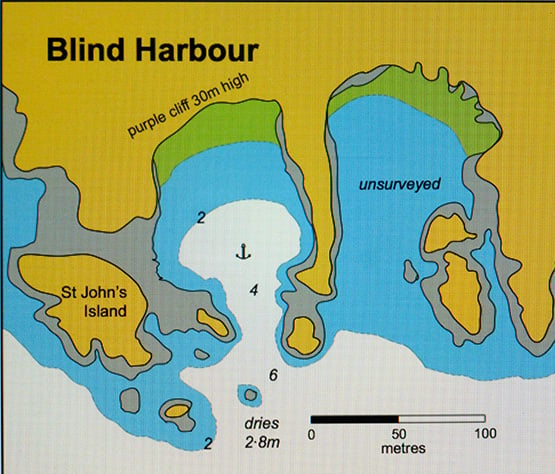
The newly-surveyed Blind Harbour on the Waterford coast as it appears in the latest edition of the ICC’s South & West Coasts Sailing Directions published this month. Courtesy ICC.
They found they’d to eye-ball their way in to this particular Blind Harbour (there are others so-named around the Irish coast) using the echo sounder, as any reliance on electronic chart assistance would have had them on the nearest part of County Waterford, albeit by only a matter of feet. With a similar exercise a couple of years ago, they found that the same thing was the case at the Joyce Sound Pass inside Slyne head in Connemara – rely in the chart plotter, and you’re making the pilotage into “impactive navigation”.
The message is that some parts of charts are still relying on surveys from a very long time ago, and locations of hyper-narrow channels may be a few metres away from where they actually are. On the other hand, electronic anomalies may arise. Whatever the reason, I know that a couple of years ago, in testing the ship’s gallant little chart plotter we headed for the tricky-enough Gillet passage inside the South Briggs at the south side of the entrance to Belfast Lough, and found that it indicated the rocks as shown were a tiny bit further north than we were seeing, which could have caused a but of a bump if we’d continued on our electronic way.
Electronic charts are only one of many topics which will be covered today. We hope to bring a full report next Saturday, for the participants will in turn require a day or two to digest their findings.





























